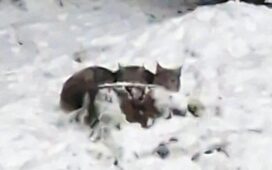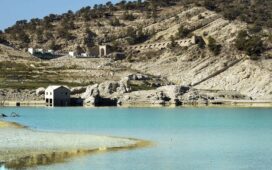It is arrant nonsense for hopeful meliorists to assure us that the bloody orgy of Spain’s Sundays and fiestas is on the wane, or that “futbol” and kindred sports are steadily supplanting the corrida de toros which has been the national pastime of Iberian millions for hundreds of years. On the contrary, bullrings now tend to grow vaster in size and cost. Madrid’s new plaza will hold nearly 40,000 spectators. Industrial Barcelona has yet another superb arena; so has languorous Seville. Every city and town, however poor, must have its national circus; the most primitive village will, on merry days, make a ring of its own with wagons and let loose a string of local bulls, with young lawyers and traders as amateur matadors, with a rag-tag of mounted picadors, banderilleros, puntilleros, monosabios, and all the rest of the age-old cuadrilla and hierarchy of bull-baiting Spain. Both church and state have made vain and feeble gestures to suppress the bullfight. It is in the widest sense a “national industry,” engaging the highest grandees as breeders; calling for special bull trains full of sinister wheeled cases, and a horde of mayorales and attendants to care for the bulls en route.
The best authorities compute that, from first to last, los toros cost a backward and still largely illiterate Spain at least 500,000,000 pesetas a year. Bulls are bred for strength, for feline swiftness of turn, and a blind fury that will charge and smash anything that moves, whether animate or inanimate. It stands to reason, then, that the breeding farm of a typical noble like the Duque of Veragua can only be established far from any human habitations and from the roads and trails of civilisation.
Spanish children play in the gutter with coat and stick as the make-believe muleta and sword of the vast arena, where heroes in cloth of gold and silver loom as the idols of an historic nation which long ago dropped out of the counsels of Europe. A first-class corrida – say, that of the press in Madrid – is in some ways a magnificent and strangely exotic scene. When the king and queen are present all the ladies wear the traditional high combs and mantillas, while their superb embroidered mantones are hung out upon the boxes.
To martial music the dazzling cuadrilla, streams in across the blazing sand, and four of Spain’s greatest diestros salute the president and his jury. For every act is done by rule and signal. The entry of the bull is a thrilling sight; so is the cape-play of a first-rate artist,” who seems to juggle with death in a dance of amazing skill and courage. The rest is dreadful and heart-rending.
Cruelty begins with the vengeful pounce of the bull out of a cautiously opened door. As he tumbles in, a long needle is driven from above into his sleek shoulders, carrying the gay silken divisa or ribbon-badge of his breeder. Blindfold horses are spurred at him in the second act. As he plunges at them the bull is severely speared by the picador. In goring a horse the savage brute often rips him from end to end. Often the dying horse falls upon his prostrate rider, breaking the man’s bones or giving him grave concussion.
Fallen horses are flogged on to their legs, while thousands of gentle women and young children survey the horrible sight upon the Lord’s Day after the morning Mass.
Cruelty is carried to incredible extremes. A piteous sight is the bull himself, with four or six “fish-hook” darts planted in his bloody hide, roaring and shuddering with pain. More dreadful still are the firework goads used upon a manso, or “spiritless” bull who declines to face the picador’s lance or play the capes with the headlong brio which the hordes of gazing aficionados consider can alone make a worthy showing. Otherwise oranges, cushions, or even bottles may be hurled at yesterday’s golden hero of all Spain. I have known even pistol-shots to be fired from excited spectators at a bull which did not “fulfil,” as the native idiom has it. And the last of all popular protests (which I once saw to my alarm in Málaga) is to set the gallery seats ablaze, in defiance of armed police and soldiery who swarm on duty at these highly emotional orgies.
Here the tragedy of young Joselito may be cited. This boy was a matador of matchless daring, of great renown, and great fortune, too. Yet he met his doom in the shabby plaza of Talavera de la Reina. A manso bull brought jeers and odium even to Joselito. And having sent all his helpers away the hero of fickle Spain advanced to slay a brute of saurian cunning. A lightning pounce, and the lad was mortally gored as well as flung up on high like a child’s toy. He lived but ten minutes in the bullring hospital. Young Joselito had a state funeral such as rivalled that of Ferdinand Filch, with his King and Queen, Senate and Chamber, nobility and democracy all represented; with all business suspended and tearful clubs lay the wagonload in the interminable cortege. And that boy – a figure of Hellenic beauty – left a fortune of seven million pesetas. Is it any wonder that the glow of his glory fills the dream of every boy in Spain.
The other day, in lovely and brilliant San Sebastián, I saw the familiar scenes of blood and sand; of thousands of hot, eager faces of crowded streets, coroneted cars, golden cuadrillas, and all the frigid horrors upon which el arte marina insists. The wretched horses now wear a sort of quilted “armour.” Yet the very first bull tore the very first horse to shapeless shreds, till the capemen drew him off his prey and monosabios of the ring threw decent sacking over the horror … whilst yet other horses were spurred upon blood horns and pawing hoofs of reckless fury.
after newsletter promotion
Empire and monarchy, republic and dictatorship – these have come and gone in more or less lurid “reels” of history. But the Sunday bullfight remains, with all its crude butchery and torment of blood and fire in a largely illiterate and sadly neglected land of quite incredible contrasts. What Spain’s fine scholars and true elite think of this taurine “art” is a theme I cannot deal with here. But assuredly Morocco and the bullfight have much to answer for to the apathetic people of Spain.














